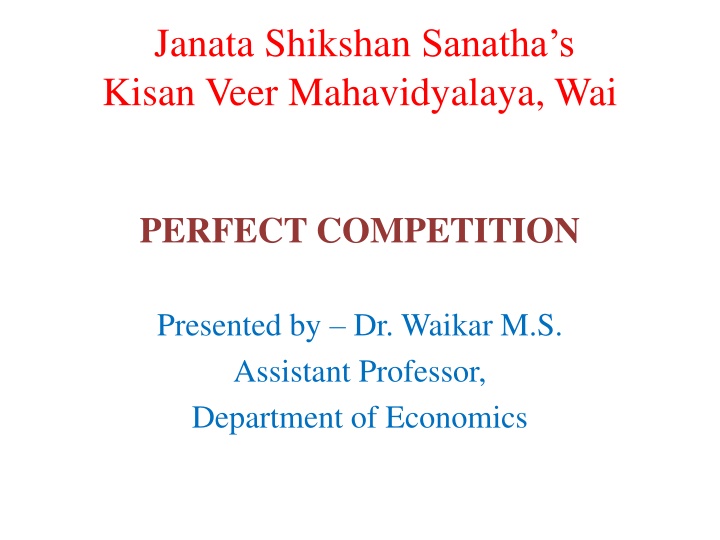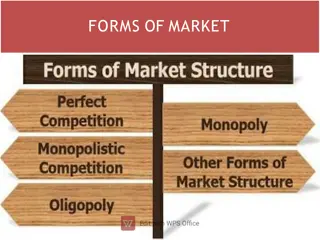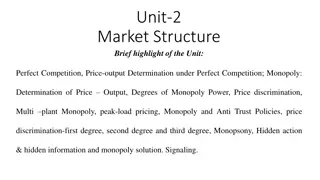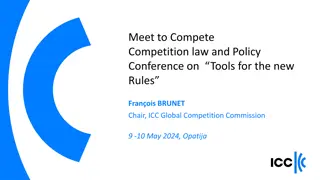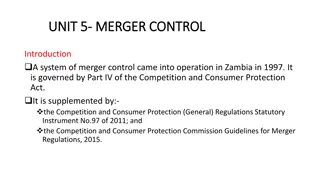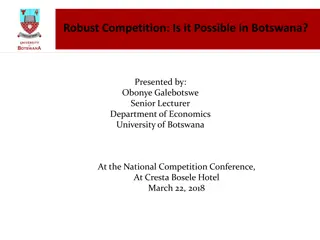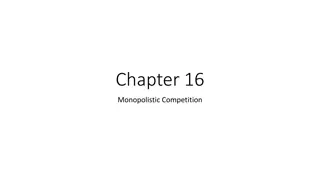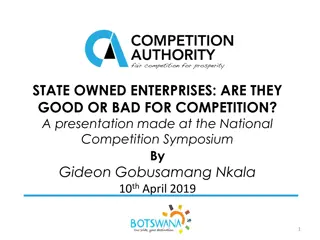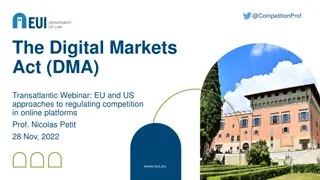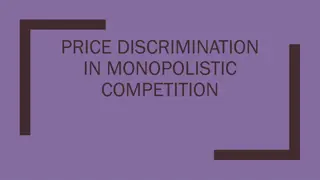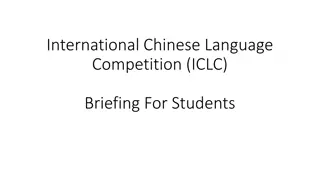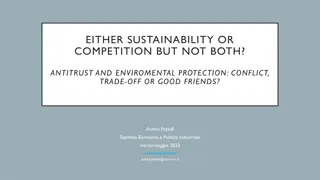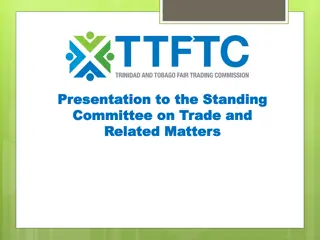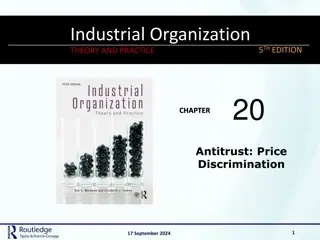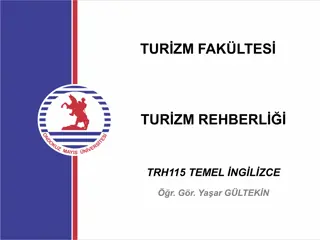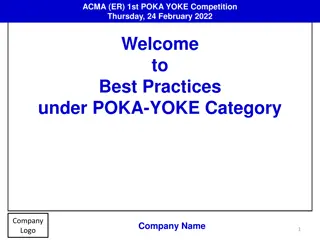Perfect Competition at Wai: Presented by Dr. Waikar
Join an insightful session on perfect competition at Janata Shikshan Sanathas Kisan Veer Mahavidyalaya, Wai, led by Dr. Waikar M.S., Assistant Professor of Economics. Explore the key principles of perfect competition and its implications in the market. Gain a comprehensive understanding that can empower your economic knowledge.
Download Presentation

Please find below an Image/Link to download the presentation.
The content on the website is provided AS IS for your information and personal use only. It may not be sold, licensed, or shared on other websites without obtaining consent from the author.If you encounter any issues during the download, it is possible that the publisher has removed the file from their server.
You are allowed to download the files provided on this website for personal or commercial use, subject to the condition that they are used lawfully. All files are the property of their respective owners.
The content on the website is provided AS IS for your information and personal use only. It may not be sold, licensed, or shared on other websites without obtaining consent from the author.
E N D
Presentation Transcript
Janata Shikshan Sanathas Kisan Veer Mahavidyalaya, Wai PERFECT COMPETITION Presented by Dr. Waikar M.S. Assistant Professor, Department of Economics
PERFECT COMPETITION Unit I: Perfect competition: 1.1Meaning -Equilibrium of firm in short run and long run. 1.2Equilibrium of industry in short run and long run. 1.3Measuring producer s surplus under perfect competition.
Meaning and Definition of Perfect Competition: A Perfect Competition market is that type of market in which the number of buyers and sellers is very large, all are engaged in buying and selling a homogeneous product without any artificial restrictions and possessing perfect knowledge of the market at a time.
Meaning and Definition of Perfect Competition: In other words it can be said A market is said to be perfect when all the potential buyers and sellers are promptly aware of the prices at which the transaction take place. Under such conditions the price of the commodity will tend to be equal everywhere.
Meaning and Definition of Perfect Competition: Mrs. Competition prevails when the demand for the output of each producer is perfectly elastic. According to Boulding A Perfect Competition market may be defined as a large number of buyers and sellers all engaged in the purchase and sale of identically similar commodities, who are in close contact with one another and who buy and sell freely among themselves. Joan Robinson has said Perfect
Characteristics of Perfect Competition: 1. Large Number of Buyers and Sellers: The first condition is that the number of buyers and sellers must be so large that none of them individually is in a position to influence the price and output of the industry as a whole. In the market the position of a purchaser or a seller is just like a drop of water in an ocean.
Characteristics of Perfect Competition: 2. Homogeneity of the Product: Each firm should homogeneous product so that no buyer has any preference for the product of any individual seller over others. homogeneous then price will also be uniform everywhere. produce and sell a If goods will be
Characteristics of Perfect Competition: 3. Free Entry and Exit of Firms: The firm should be free to enter or leave the market. If there is hope of profit the firm will enter in business and if there is probability of loss, the firm will leave the business.
Characteristics of Perfect Competition Market : 4. Perfect Knowledge of the Market: Buyers and sellers must possess complete knowledge about the prices at which goods are being bought and sold and of the prices at which others are prepared to buy and sell. This will help in having uniformity in prices.
Characteristics of Perfect Competition Market : 5. Perfect Mobility of the Factors of Production and Goods: There should be perfect mobility of goods and factors between industries. Goods should be free to move to those places where they can fetch the highest price.
Characteristics of Perfect Competition Market : 6.Absence of Price Control: There should be complete openness in buying and selling of goods. Here prices are liable to change freely in response to demand.
Characteristics of Perfect Competition Market : 7. In Long Run all firm get Normal Profit: Due to free entry and free exit all the firm in market got normal profit only. If existed firm in the market got abnormal profit then new firm will enter into the market so that abnormal profit of existed firm will decreases.
Characteristics of Perfect Competition Market : 8. No Selling Cost: Under perfect competition, there are no selling costs because the products of all the firms are homogeneous.
Characteristics of Perfect Competition Market : 9. No Transport Costs: There shall not be any cost of transport between sellers. If transport costs exist buyers are prevented from moving from one seller to another to take advantage of price difference. This means that transport cost has no influence on the pricing of a product. In other words, these are always uniform price in the market.
CONCEPT OF FIRM AND INDUSTRY Introduction In economics, a firm holds important position as at the firm level managerial decisions are taken. In common language a firm is considered as a manufacturing unit involved in production of goods. The scope of the term firm in economics is broad. It represents any business organization inhering service & agriculture organization also.
Definition of Firm Some definitions of firm given by renowned economists are given below. 1. Firm is a unit of production that employs factors of production (or inputs) to produce goods & services under given state of technology. 2. It is an independently administered business unit Hanson. 3. It is a center of control where the decisions about what to produce & how to produce are taken. 4. It is a business unit which hires productive resources for the purpose of producing goods & services.
Features of firm Features of firm emerge which are listed below. 1. It is a place where all decision making related to production are taken viz what, where & how much to produce. 2. It is a place where manpower is hired for production. 3. It is a place where all the resources of production are brought together, production is done as well as sale & distribution of the manufactured product is carried out. 4. The state of technology is defined by the firms production function.
Industry Industry is a group of related firms. The relationship between the firms may be either based upon product or process criterion, e.g. dairy industry or food processing industry etc. The concept of industry is helpful to government and businessmen to formulate their policies.
Equilibrium of the Firm: Meaning: A firm is in equilibrium when it has no tendency to change its level of output. It needs neither expansion nor contraction. It wants to earn maximum profits. In the words of A.W. Stonier and D.C. Hague, A firm will be in equilibrium when it is earning maximum money profits. Equilibrium of the firm can be analyzed in both short-run and long-run periods. A firm can earn the maximum profits in the short run or may incur the minimum loss. But in the long run, it can earn only normal profit.
Conditions of the Equilibrium of Firm: A firm is said to be in equilibrium when it satisfies the following conditions: 1. The first condition for the equilibrium of the firm is that its profit should be maximum. 2. Marginal cost should be equal to marginal revenue. 3. MC must cut MR from below.
Short Run Equilibrium of Firm in Perfect Competition Market
Long Run Equilibrium of Firm in Perfect Competition Market
Meaning of Industry Industry is a group of firms producing homogeneous products in a market. In the words of Prof. Miller, Industry is a group of firms that produces a homogeneous product. For example, Raymond, Maffatlal, Arvind, etc., are cloth manufacturing firms, whereas a group of such firms is called the textile industry.
Equilibrium of the Industry under Perfect Competition: Two Conditions of the industry equilibrium: i) There is no tendency for the firms either to leave or enter the industry. i.e. The numbers of firms remain constant.(SAC = AR ----- Normal Profit) (ii) Each firm is also in equilibrium. (SMC = MR)
Short-Run Equilibrium of the Industry In Perfect Competition Market An industry is in equilibrium in the short run when its total output remains steady, there being no tendency to expand or contract its output. If all firms are in equilibrium, the industry is also in equilibrium. For full equilibrium of the industry in the short run, all firms must be earning only normal profits. The condition for this is SMC = MR = AR = SAC. But full equilibrium of the industry is by sheer accident because in the short run some firms may be earning supernormal profits and some incurring losses.
Short-Run Equilibrium of the Industry In Perfect Competition Market
Explanation of Above Diagram in Figure 4, where in Panel (A), the industry is in equilibrium at point E where its demand curve D and supply curve S intersect which determine OP price at which its total output OQ is cleared. But at the prevailing price OP some firms are earning supernormal profits PE1ST as shown in Panel (B), while some other firms are incurring FGE2P losses as shown in Panel (C) of the figure.
Long-Run Equilibrium of the Industry In Perfect Competition Market: The industry is in equilibrium in the long run when all firms earn normal profits. There is no incentive for firms to leave the industry or for new firms to enter homogeneous and given their prices and the same technology, each firm and industry as a whole are in full equilibrium where LMC = MR =AR(=p) =LAC at its minimum. Such an equilibrium position is attained when the long-run price for the industry is determined by the equality of total demand and supply of the industry. it. With all factors
Long-Run Equilibrium of the Industry In Perfect Competition Market:
Explanation of above Diagram The long-run equilibrium of the industry is illustrated in Figure 5(A) where the long-run price op and OQ output are determined by the intersection of the demand curve d and the supply curve s at point E. At this price op, the firms are in equilibrium at point A in Panel (B) at OM level of output where LMC =SMC= MR= p (=AR) =SAC= LAC at its minimum. At this level, the firms are earning normal profits and have no incentive to enter or leave the industry. It follows that when the industry is in long-run equilibrium, each firm in the industry is also in long-run equilibrium. If both the industry and the firms are in long-run equilibrium, they are also in short-run equilibrium.
Price and Output Determination under Perfect Competition Perfect competition refers to a market situation where there are a large number of buyers and sellers dealing in homogenous products. Moreover, under perfect competition, there are no legal, social, or technological barriers on the entry or exit of organizations. In perfect competition, sellers and buyers are fully aware about the current market price of a product. Therefore, none of them sell or buy at a higher rate. As a result, the same price prevails in the market under perfect competition.
Price and Output Determination under Perfect Competition Under perfect competition, the buyers and sellers cannot influence the market price by increasing or decreasing their purchases or output, respectively. The market price of products in perfect competition is determined by the industry. This implies that in perfect competition, the market price of products is determined by taking into account two market forces, namely market demand and market supply. In the words of Marshall, Both the elements of demand and supply are required for the determination of price of a commodity in the same manner as both the blades of scissors are required to cut a cloth. As discussed in the previous chapters, market demand is defined as a sum of the quantity demanded by each individual organizations in the industry.
Price and Output Determination under Perfect Competition On the other hand, market supply refers to the sum of the quantity supplied by individual organizations in the competition, the price determined at a point at which the demand and supply curve intersect each other. This point is known as equilibrium point as well as the price is known as equilibrium price. In addition, at this point, the quantity demanded and supplied is called equilibrium quantity. industry. In of perfect a product is
Demand under Perfect Competition Market: Demand refers to the quantity of a product that consumers are willing to purchase at a particular price, while other factors remain constant. A consumer demands more quantity at lower price and less quantity at higher price. Therefore, the demand varies at different prices.
Demand curve under perfect competition:
Explanation of Above Diagram As shown in Figure-1, when price is OP, the quantity demanded is OQ. On the other hand, when price increases to OP1, the quantity demanded reduces to OQ1. Therefore, under perfect competition, the demand curve (DD ) slopes downward.
Supply under Perfect Competition: Supply refers to quantity of a product that producers are willing to supply at a particular price. Generally, the supply of a product increases at high price and decreases at low price.
supply curve under perfect competition: In Figure-2, the quantity supplied is OQ at price OP. When price increases to OP1, the quantity supplied increases to OQ1. This is because the producers are able to earn large profits by supplying products at higher price. Therefore, under perfect competition, the supply curves (SS ) slopes upward.
Equilibrium under Perfect Competition(Price and Output Determination) As discussed earlier, in perfect competition, the price of a product is determined at a point at which the demand and supply curve intersect each other. This point is known as equilibrium point. At this point, the quantity demanded and supplied is called equilibrium quantity.
(Price and Output Determination in Perfect Competition Market)
Explanation of Above Diagram In Figure-3, it can be seen that at price OP1, supply is more than the demand. Therefore, prices will fall down to OP. Similarly, at price OP2, demand is more than the supply. Similarly, in such a case, the prices will rise to OP. Thus, E is the equilibrium at which equilibrium price is OP and equilibrium quantity is OQ.
Producer Surplus Producer surplus is the difference between how much a producer would be willing to accept for given quantity of a good versus how much they can receive by selling the good at the market price. The difference or surplus amount is the benefit the producer receives for selling the good in the market. A producer surplus is generated by market prices in excess of the lowest price producers would otherwise be willing to accept for their goods.
Producer Surplus Producer surplus is the total amount that a producer benefits from producing and selling a quantity of a good at the market price. The total revenue that a producer receives from selling their goods minus the total cost of production equals the producer surplus. Producer surplus plus consumer surplus represents the total benefit to everyone in the market from participating in production and trade of the good.
